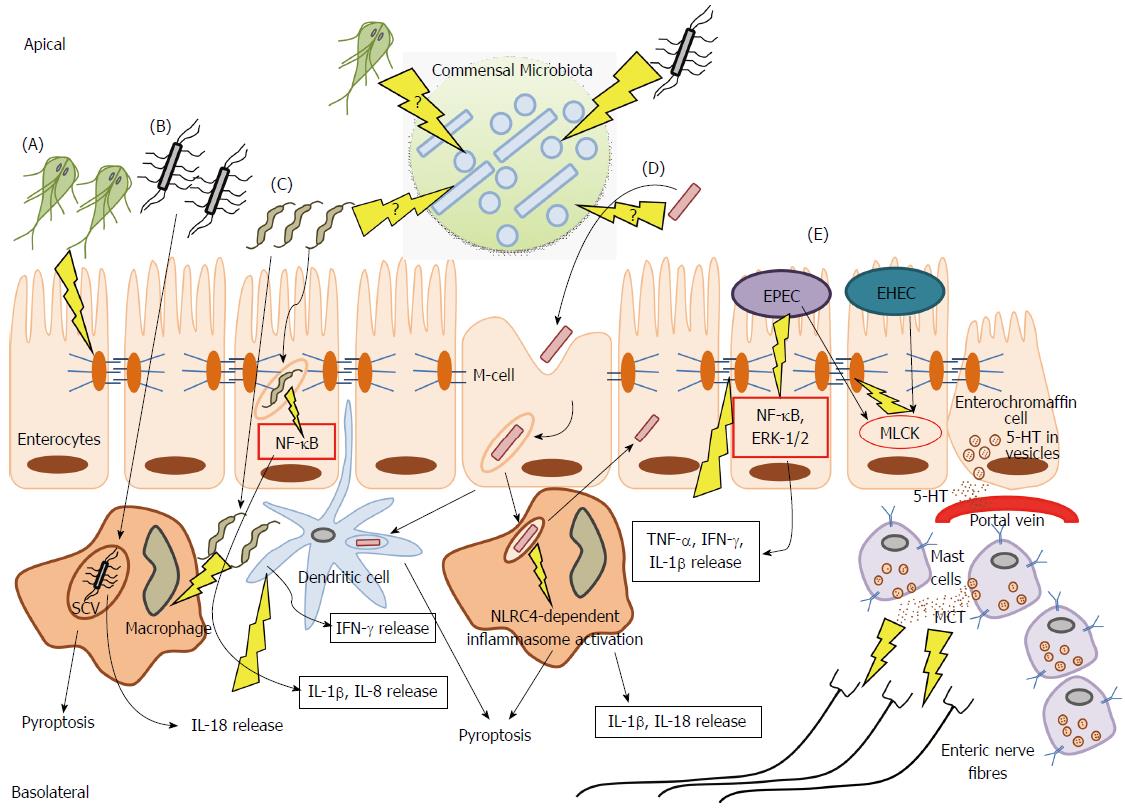Copyright
©2014 Baishideng Publishing Group Co.
World J Gastroenterol. Apr 14, 2014; 20(14): 3976-3985
Published online Apr 14, 2014. doi: 10.3748/wjg.v20.i14.3976
Published online Apr 14, 2014. doi: 10.3748/wjg.v20.i14.3976
Figure 1 Illustration representing the interaction of several pathogens with the intestinal epithelium and resident immune cells, and their contribution to the development of post-infectious-irritable bowel syndrome.
A: Giardia duodenalis disrupts tight junctional proteins in the epithelium, in addition to resulting in a decrease in 5-HT-producing enterochromaffin cells; B: Salmonella enterica serovar Typhimurium invades enterocytes and makes its way to resident macrophages, where upon being phagocytosed it causes interleukin (IL)-18 release, which further stimulates interferon (IFN)-γ release from nearby immune cells, i.e., lamina propria dendritic cells, and macrophage pyroptosis. This pathogen is also able to disrupt the resident microbiota; C: Campylobacter jejuni causes disruptions in TLR9 signaling to make epithelial cells more susceptible (would sensitive apply here instead of susceptible) even to mild pro-inflammatory cytokines. It also activates the NF-κB pathway to result in an IL-1β and IL-8 release. C. jejuni has also been shown, particularly in cases of post infectious (Pi)-IBS, to cause a reduction of resident CD68+ macrophages; D: Shigella flexneri crosses the epithelium through the M cell and is taken up resident macrophages, where it causes IL-1β and IL-18 release, and pyroptosis in these macrophages. S. flexneri has also been associated with increased number of mast cells, secretions of which MCT can activate the enteric nervous system; E: EPEC results in TNF-α, IFN-γ, and IL-1β release via NF-κB and ERK-1/2 activation. Both EPEC and EHEC result in MLCK-dependent tight junctional disruption. Intriguingly, G. duodenalis (A) and C. jejuni (C) have been implicated in the modification of the intestinal microbiota; however, the effects of this modification remain unclear[90]. A variety of combinations of these factors may contribute to the pathogenesis of PI-IBS. MCT: Mass cell tryptase.
- Citation: Beatty JK, Bhargava A, Buret AG. Post-infectious irritable bowel syndrome: Mechanistic insights into chronic disturbances following enteric infection. World J Gastroenterol 2014; 20(14): 3976-3985
- URL: https://www.wjgnet.com/1007-9327/full/v20/i14/3976.htm
- DOI: https://dx.doi.org/10.3748/wjg.v20.i14.3976













